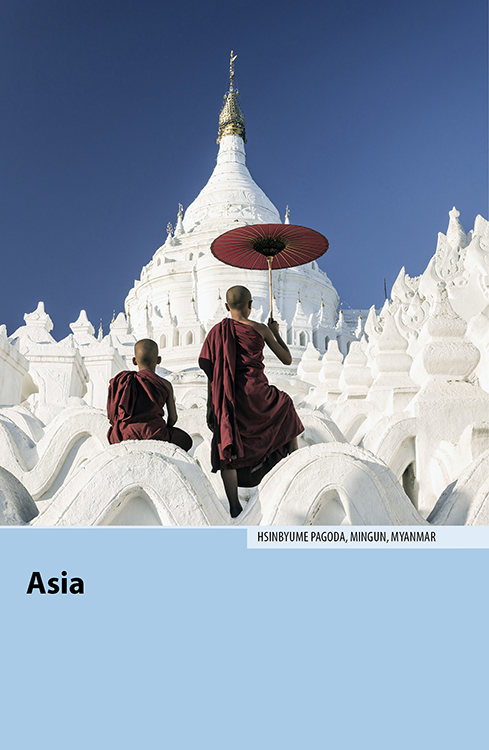
To some travellers, Asia is the home of the most exhilarating natural landscapes on the planet in the form of the soaring Himalayas. To others, it’s a collection of frenzied cities and remote cultures connected by rough local transport through countless terraced rice paddies. Many see Asia as the epicentre of spiritual enlightenment. Some think of the geisha and tea houses of Japan or the surfable breaks of Indonesia. And some travellers simply think: it’s cheap. The truth is that Asia has something for everyone. It’s really just a matter of deciding what you’re after. The low prices (outside Japan, Bhutan, Hong Kong and Singapore anyway) make most activities and journeys financially feasible for travellers on the lowest budgets. Surprisingly, though, much of Asia is still relatively untouched by the travel circuit, and if you’re willing to forgo the comforts of the backpacker infrastructure, it’s yours to discover.
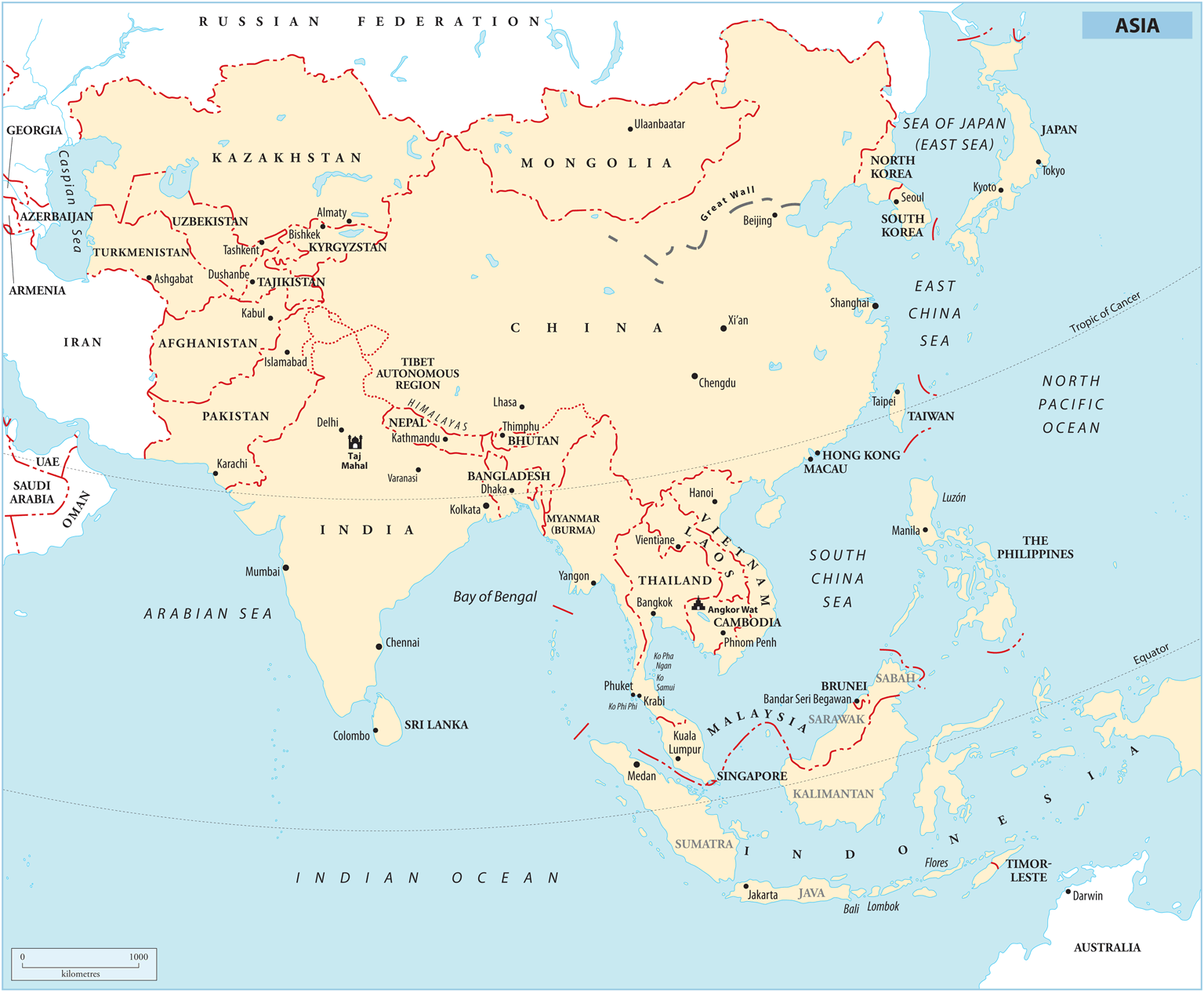

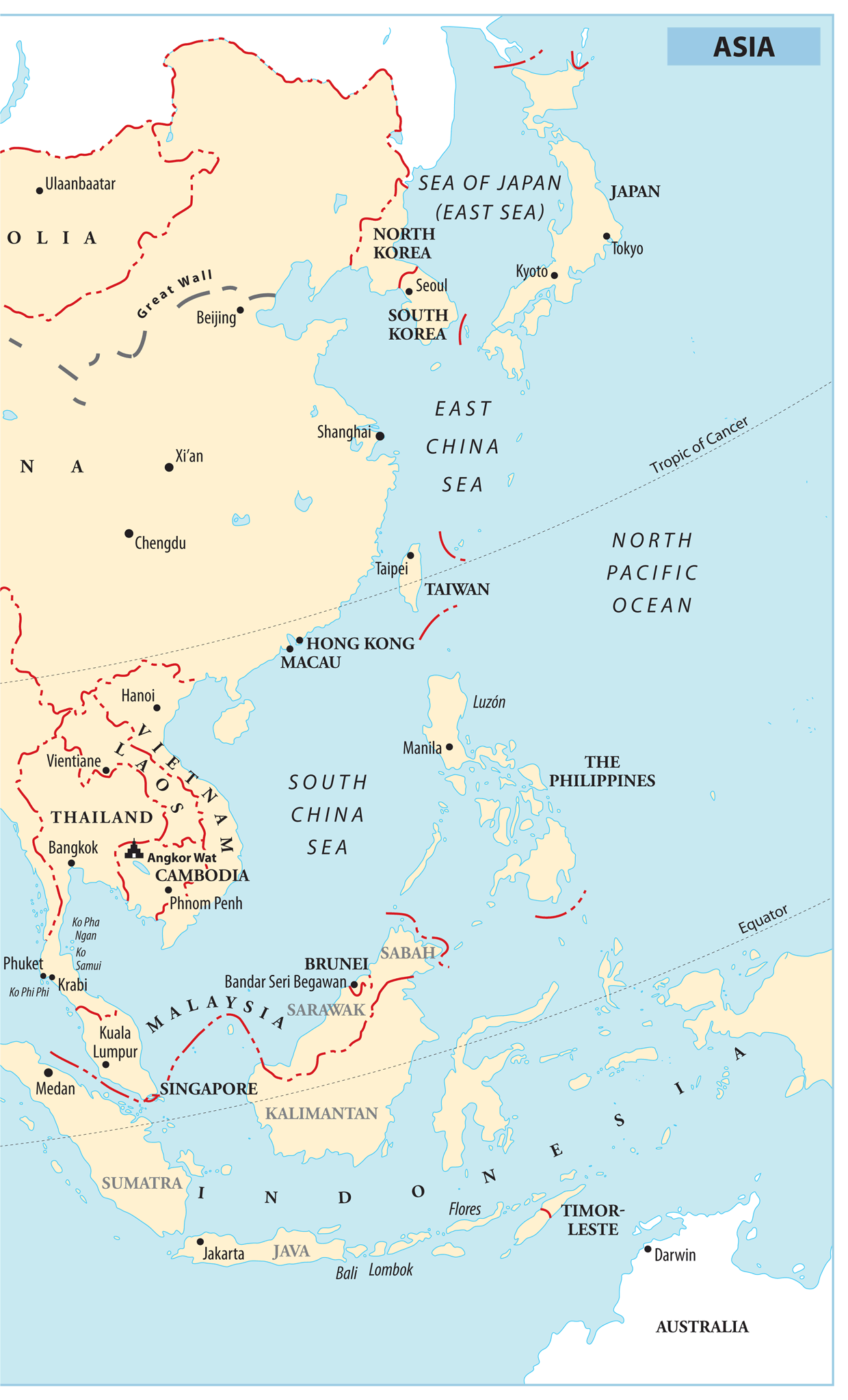
MAIN ATTRACTIONS
1 Angkor Wat Siem Reap, Cambodia. This remarkable collection of one hundred temples and palaces (stretching over 60 square kilometres) was built by Khmer kings between the ninth and fourteenth centuries. It’s only part of a much larger holy site that has been swallowed by the surrounding jungle over the last five hundred years.
2 The Great Wall China. The unusual thing about this attraction is that you can’t see it. You can, of course, see a tiny portion of it no matter where you stand – perhaps 20–40km in either direction – but precisely what makes it so incredible is the other 5960km out of view. Its appeal certainly isn’t its defensive record – it was never effective at keeping invaders out. Most people just rode up, bribed the guards at one of the checkpoints and went on through. The Wall was, however, an example of China’s forward thinking. Who else could have imagined the publicity payoff of giving astronauts something to look at from outer space?
3 Nepal’s Himalayas Trekking is an activity that people come from around the world to try, yet it’s almost never practised by locals. Nepalese simply don’t head out on trekking tours. Many walk on the same trails, but only when they need to get somewhere. The hair-raising vistas, sense of adventure and cheap guesthouses along the trails lure tens of thousands of travellers each year.
4 Taj Mahal Agra, India. Bring your sunglasses. This white marble mausoleum has glacier-like reflective properties that your retinas won’t forget in a hurry. Built in 1632–1653 by Emperor Shah Jahan in loving memory of his second wife, Mumtaz Mahal, who died prematurely from childbirth complications, the Taj is an architectural marvel that has been crafted down to the most minute detail.
5 Thailand’s beaches Thailand doesn’t have a monopoly on Southeast Asia’s great beaches, but travellers simply can’t seem to return home without an obligatory white-sand sizzle (both sides, extra crispy) on the eastern shores or the west coast (now protected by a tsunami-alarm system). There are still undeveloped stretches to be found, but as the word gets out, little palm-tufted islands and inlets are transformed from cheap backpacker hang-outs into fully fledged resorts right before your eyes.
6 Bagan Myanmar. This otherworldly archeological site is a plain dotted with 2229 Buddhist temples and pagodas of different sizes. During the city’s most prosperous period around the twelfth century, it had more than ten thousand. The nearby Irrawaddy River adds to the striking scenery. Accessible from the airport at Nyaung U, or by overnight train (18hr) or bus (9hr) from Yangon.
SECURITY ISSUES
It’s always a good idea to check the current political conditions before visiting a country (see Chapter 15), but the following are worth a little extra research: Afghanistan, Azerbaijan, Bangladesh, India, Indonesia, Kyrgyzstan, Malaysia, Myanmar (Burma), Pakistan, Philippines, Sri Lanka, Tajikistan, Uzbekistan.
WHEN TO GO
In northern Asia, spring (March–May) and autumn (Sept–Nov) are ideal; summer can get stifling, but the harsh winters (Dec–Feb) make travelling the most uncomfortable. Which is fine, because that’s a great time to be in southern Asia, the Indian subcontinent in particular. The trickiest thing, perhaps, is planning a good time to trek, if that’s your cup of chai. In Nepal, September to December is widely regarded as the best trekking season, but October to November is so popular that the crowds can easily disrupt the enjoyment and make it feel more like a weekend queue for the Louvre. Consider mid-September and early to mid-December, the brief shoulder seasons without the human traffic jams. The famous monsoon of India could keep you hot and drenched from June to September (though not in the northern hills), but it’s not as severe in Cambodia, Laos, Thailand or Vietnam. In southern Thailand, Malaysia and parts of Indonesia, finding better weather can simply be a matter of heading to the opposite coast, a few hours away.
RECOMMENDED VACCINATIONS
- Routine boosters for measles/mumps/rubella (MMR), diphtheria/pertussis/tetanus (DPT) and polio virus
- Hepatitis A
- Hepatitis B
- Japanese encephalitis (rural farming areas)
- Rabies (optional)
- Typhoid
- Yellow fever (required in some countries if arriving from a risk area)
GETTING AROUND BY AIR
Some domestic flights are surprisingly cheap, so before you head off to a bus station for another twelve-hour journey, consider taking a peek at some local fares. You may decide it’s worth the extra £13–44/$20–69 or whatever the difference may be. From Bangkok, you can fly nearly anywhere in Asia for £47–158/$73–247 (or with good timing, even less). Domestic one-way tickets in China cost £63–189/$98–295 and in India £32–95/$50–148.
LOWEST DAILY BUDGET
Expensive (£45/$70):
Bhutan, Brunei, the east coast of China, Hong Kong, Japan, Mongolia, Singapore
Mid-range (£30–45/$47–70):
Mainland China, Malaysia, Philippines, South Korea, Taiwan, Thailand
Budget (£12–25/$19–39):
Bangladesh, India, Indonesia, Laos, Myanmar, Nepal, Pakistan, Vietnam
AIR PASSES
Most air passes must be purchased in advance, outside the country, and are probably best coordinated with your international ticket. If you’ve already arrived with an international carrier and you have a clever travel agent back home who has all the records from your trip, you may be able to work things out and have a ticket sent to you.
ASIA
- Visit Asia Airpass
 oneworld.com. The
One World Alliance offers up fifty cities in eighteen
countries on ten airlines. There’s a minimum of two flights
but no upper limit. The price is based on seven zones
according to the length of each flight – but expect to save
up to thirty percent on normal fares.
oneworld.com. The
One World Alliance offers up fifty cities in eighteen
countries on ten airlines. There’s a minimum of two flights
but no upper limit. The price is based on seven zones
according to the length of each flight – but expect to save
up to thirty percent on normal fares. - AirAsia Asean Airpass
 airasia.com/ot/en/book-with-us/asean-pass.page.
Travel between the ten countries of the Association of
Southeast Asian Nations (which include Cambodia, Laos and
Myanmar) on low-budget airline AirAsia. Choose between ten
credits during thirty days of travel and twenty credits
during sixty days of travel. Individual flights cost one,
three or five credits. Itineraries must be set at the time
of purchase, but can be changed for a fee.
airasia.com/ot/en/book-with-us/asean-pass.page.
Travel between the ten countries of the Association of
Southeast Asian Nations (which include Cambodia, Laos and
Myanmar) on low-budget airline AirAsia. Choose between ten
credits during thirty days of travel and twenty credits
during sixty days of travel. Individual flights cost one,
three or five credits. Itineraries must be set at the time
of purchase, but can be changed for a fee. - Sky Team Go Asia Pass
 skyteam.com/en/Flights-and-Destinations/Travel-Passes/Go-Asia.
Available if you fly to and from Asia with one of the twenty
Sky Team members through one of their Asian gateways –
Beijing, Guangzhou, Hanoi, Saigon, Seoul, Shanghai, Taipei
and Tokyo. There is a minimum of three coupons and maximum
of sixteen. You can begin and end in different countries,
and there are no minimum stay limits. Destinations include
the usual suspects plus Mongolia, Nepal and Guam. Expect to
save up to 75 percent on normal fares.
skyteam.com/en/Flights-and-Destinations/Travel-Passes/Go-Asia.
Available if you fly to and from Asia with one of the twenty
Sky Team members through one of their Asian gateways –
Beijing, Guangzhou, Hanoi, Saigon, Seoul, Shanghai, Taipei
and Tokyo. There is a minimum of three coupons and maximum
of sixteen. You can begin and end in different countries,
and there are no minimum stay limits. Destinations include
the usual suspects plus Mongolia, Nepal and Guam. Expect to
save up to 75 percent on normal fares. - Star Alliance Asia Airpass
 staralliance.com/en/fares/asia-airpass. Fly to
any ten of 277 available destinations in nineteen countries,
with twelve different airlines. Choose between three and ten
coupons. A change of flights uses up another coupon. Valid
for three months. At least two 24-hour stopovers in
different cities are required, and the same sector cannot be
travelled more than once. Dates and flights must be decided
in advance. Save up to thirty percent on normal
fares.
staralliance.com/en/fares/asia-airpass. Fly to
any ten of 277 available destinations in nineteen countries,
with twelve different airlines. Choose between three and ten
coupons. A change of flights uses up another coupon. Valid
for three months. At least two 24-hour stopovers in
different cities are required, and the same sector cannot be
travelled more than once. Dates and flights must be decided
in advance. Save up to thirty percent on normal
fares.
JAPAN
- JAL Welcome to Japan
 jal.co.jp/yokosojapan. Flights between 59
Japanese airports with prices based on a fixed sector rate.
Valid on up to five flights operated by JAL and Japan
TransOcean Air in Okinawa. Fly to Japan on any carrier you
like, but take note of the three annual blackout periods:
the second half of March, mid-August and the second half of
December.
jal.co.jp/yokosojapan. Flights between 59
Japanese airports with prices based on a fixed sector rate.
Valid on up to five flights operated by JAL and Japan
TransOcean Air in Okinawa. Fly to Japan on any carrier you
like, but take note of the three annual blackout periods:
the second half of March, mid-August and the second half of
December. - One World Yokoso/Visit
Japan
 jal.co.jp/yokosojapan. Low-budget variant of the
Welcome to Japan pass. Only covers thirty destinations
around the country, and you have to arrive in the country
with a One World Airline. Uses a similar sector system for
up to five flights operated by JAL, and Japan TransOcean
Air, and the same blackout periods as above.
jal.co.jp/yokosojapan. Low-budget variant of the
Welcome to Japan pass. Only covers thirty destinations
around the country, and you have to arrive in the country
with a One World Airline. Uses a similar sector system for
up to five flights operated by JAL, and Japan TransOcean
Air, and the same blackout periods as above.
THAILAND
- Discovery Airpass
 bangkokair.com/pages/discovery_airpass/discovery-airpass.
Covers over thirty destinations in Southeast Asia served by
Bangkok Airlines and Lao Airlines. The minimum purchase is
three coupons and the maximum is six, and the pass is valid
for two months. Coupon prices differ between domestic and
international flights, and are graded in two tiers depending
on length of flight. Tier 2 takes you as far as Mumbai,
Dhaka, Hong Kong and the Maldives.
bangkokair.com/pages/discovery_airpass/discovery-airpass.
Covers over thirty destinations in Southeast Asia served by
Bangkok Airlines and Lao Airlines. The minimum purchase is
three coupons and the maximum is six, and the pass is valid
for two months. Coupon prices differ between domestic and
international flights, and are graded in two tiers depending
on length of flight. Tier 2 takes you as far as Mumbai,
Dhaka, Hong Kong and the Maldives.
OVERLAND ROUTES
Asia has several classic overland routes which can be avoided, adhered to or mixed and matched. One route connects Europe and Australia via the old Hippie Trail that cuts across Pakistan, India, Bangladesh, Myanmar, Thailand, Singapore, Malaysia and Indonesia.
From Moscow, you can take the Trans- Mongolian or Trans-Manchurian railways to Beijing – or vice versa. From Beijing, you’ve got a few options: the most expensive (based on per-day travel costs) is to head down the coast to Hong Kong or across the strait by ferry to South Korea and then on to Japan.
The four cheaper options are to head inland, then either:
- Through Tibet and into Nepal (check current visa info on this border crossing), then on to India, where you can pick up the trail going on to Australia.
- Along the old silk route, although the famous Khyber Pass between Afghanistan and Pakistan is closed to travellers at the moment. Instead, pick up the route to Australia via India, Thailand, Malaysia, Singapore and Indonesia.
- To Hanoi, then Laos and Bangkok.
- From Hanoi, going to Ho Chi Minh City, Phnom Penh and (possibly with a short flight here) on to Bangkok.
- Note that the classic Burma Road has been open for a couple of years now, after a postwar hiatus of over 60 years.
There’s an incredible selection of transport available, from some of the world’s least comfortable buses to high-speed trains with champagne service to colourful hand-decorated bicycle rickshaws. Between most points, however, you’ll be choosing among buses, trains, planes, boats and (if you’re in a group) a taxi. In cities, public transport can be daunting. With the right frame of mind (relaxed, perhaps mildly hungover) you will eventually get the hang of it, even if you get lost once or twice in the process. Whether or not that’s easier than learning to bargain and getting a feel for the local taxi and rickshaw prices is a tough call.
BUSES
There are modern buses in Asia – the ones that run in Japan or around Thailand are especially stunning. But you’ll invariably spend a good deal of time on the other kind. Despite what you may have heard, it’s rarely the bus that’s the problem. It’s more likely just the chain-smokers, jammed-shut windows, screaming babies, crater-like potholes, un-policed roads and reckless drivers with an affinity for high-pitched synthesizer pop music played at conversation-halting decibels. Thus the mention of “bus” and “Asia” will often conjure up “bus ride from hell” stories, which is fine because – and here’s what you need to remind yourself when hearing these – the person telling them obviously survived. Buses may not be the safest methods of transport, but they’re often the cheapest, and sometimes the only way to get where you want to go.

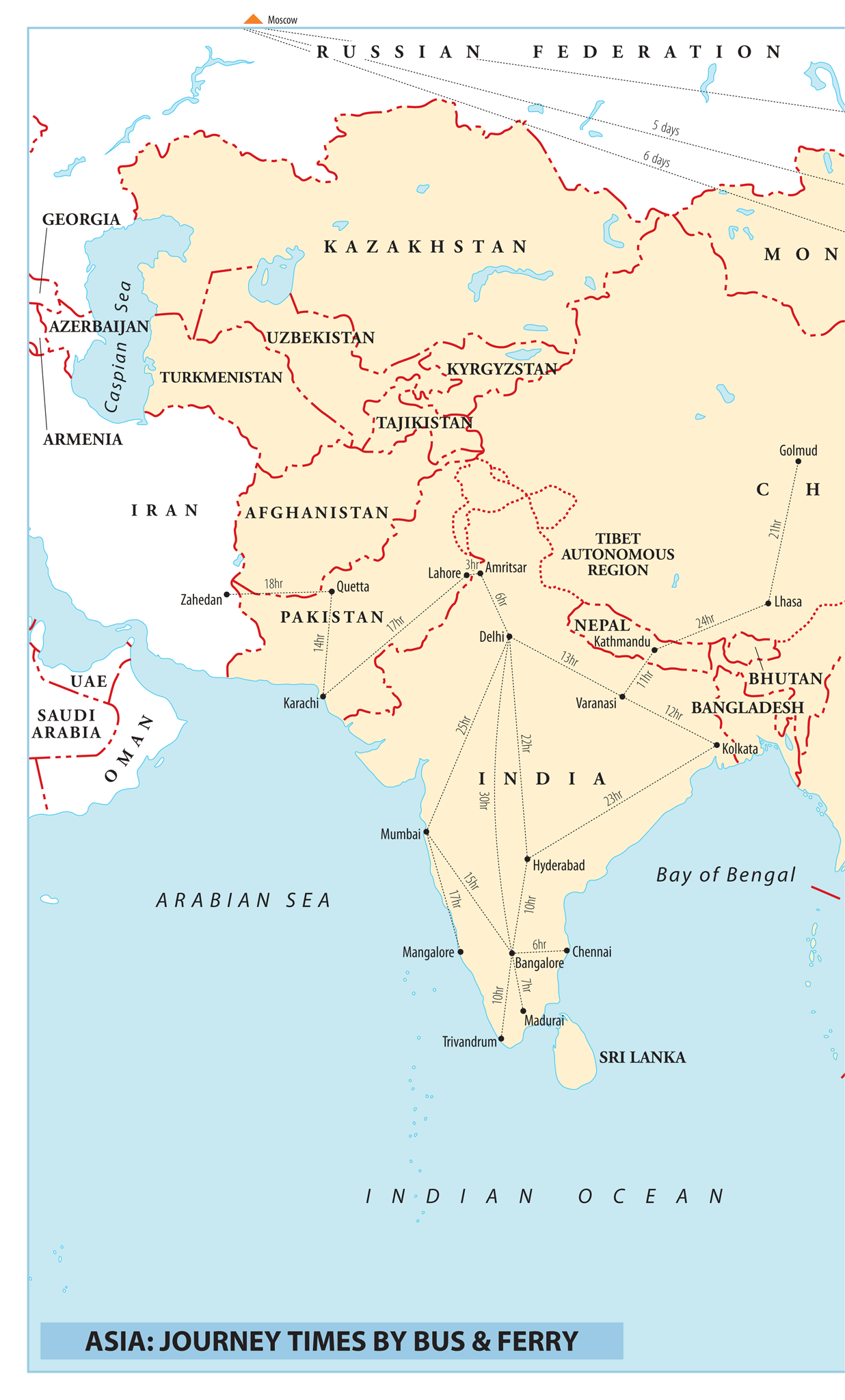
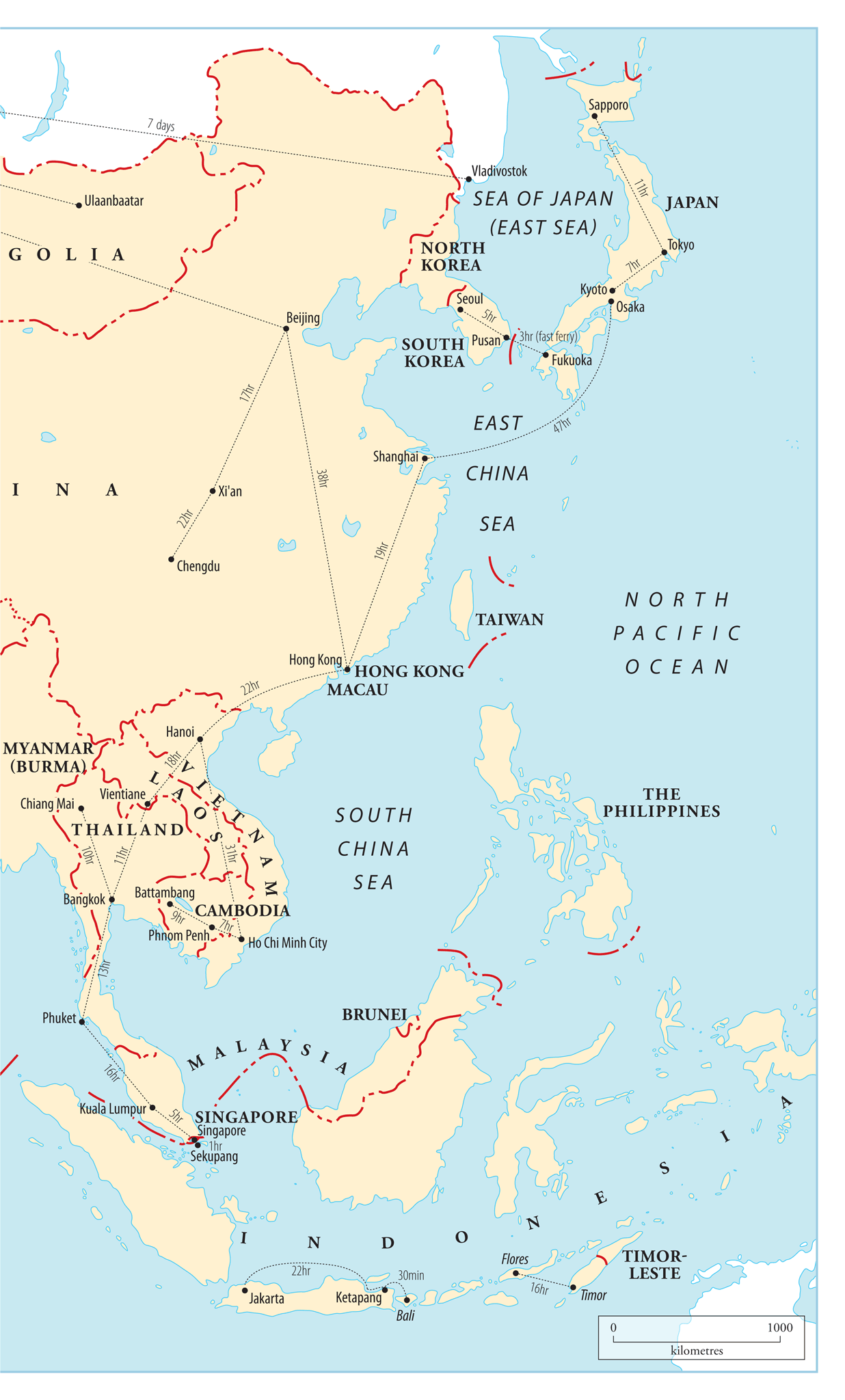
TRAINS
Japan, China and India boast the most extensive rail networks in Asia, and they’re a nice alternative to buses. That’s not to say they’ll offer the same level of escape. To even mention Japan’s and India’s trains in the same sentence requires a disclaimer: no two rail systems could be more different. The smooth, sterile, comfortable and climate-regulated high-speed trains in Japan arrive and depart on a schedule that many actually do set their watches by. Indian trains, provided you’re not in first class, feature a cast of characters that ranges from hot-food sellers or relentlessly inquisitive businessmen looking for a joint-venture partner to the sweeper who brushes out the constantly accumulating layer of rubbish on the floor. China’s trains are somewhere in between, largely dependent upon what type of cabin you’re in: “hard seats” (more people than seats), “soft seats” (same number of people as seats), “hard beds” (hard beds) or “soft beds” (fairly soft beds in a four-bed suite). China is pressing on fast with its high-speed rail network, with 16,000 kilometres as of 2014, and the magnetic levitation line from Shanghai airport already shoots passengers into town at the insane top cruising speed of 430kph.
While not cheap, Japan’s 7-, 14- and 21-day rail passes (![]() japanrailpass.net) are
at least good value – really the only way to afford the trains. With the
bullet trains, you could easily travel half the length of Japan in a day
and spend only £150/$235 in the process.
japanrailpass.net) are
at least good value – really the only way to afford the trains. With the
bullet trains, you could easily travel half the length of Japan in a day
and spend only £150/$235 in the process.
CARS
Get a taste of what you’re getting into before you rent a car. Sit in the front passenger seat of a taxi as you move about town for a few days and see if the high-speed chaos feels like something you’d be able to handle. If not, you can often hire a driver and pay even less, especially if you can find one or two other travellers to help share the cost. In more developed countries the traffic laws may not be as much of a problem, but navigating can be. In Tokyo, for example, directions are so complex most companies have resorted to printing small maps on the backs of their business cards.
If you’re planning to buy a car or motorcycle, head into it with your eyes open. That means a full understanding of the paperwork and visas you’ll need to cross any borders – which could take months to organize – and figuring out which countries require separate permits for each province. If you are handy with engines, make sure you buy a model you feel comfortable fixing, plus the tools and parts you’ll need. If you don’t have the know-how, make sure you have a model that can be fixed locally (ask about this on arrival). Better still, get a model that won’t require fixing. But that’s going to cost a lot more and it’ll have a greater chance of getting stolen, scratched or broken into.
If you want the flexibility and convenience of a car and you’re not heading across the continent, the best bet may be to rent one with a driver included and make sure you both agree on the ground rules (in fact, put them on paper) before embarking on a long journey. There’s more information on car travel in “How to get around the world”.
BIKES
Asia is the home of the bicycle. Having said that, you’re unlikely to come across any models with dual suspension, titanium frames and French derailleurs. Renting or buying a bike to ride in cities is recommended where cycling is widely practised (such as Beijing) and inadvisable where it’s not (Bangkok, for example).
Bike paths are almost nonexistent and there’s very limited space on the shoulders of major roads, so long-haul cyclists should seriously consider a mountain bike with adequate shock-absorbers, and perhaps stick to secondary roads.
As a cyclist, you’re at the bottom of the highway food-chain and cars and trucks will expect you to move out of the way. But, just in case, consider bringing ample visibility-enhancers (orange flags and Day-Glo strips) to help alert drivers who aren’t accustomed to seeing cyclists and may be kind enough to swerve.
Bring all the spare parts you’ll need for such a journey. Outside Japan, Singapore and Taiwan, you’ll have a hard time locating anything that will work with your bike, including inner tubes.
BOATS
In parts of Asia, river travel is not just a nice way to break up a trip or save some money, it’s the only way to access certain destinations. Whether or not you head up Cambodia’s Tonlé Sap to Angkor Wat, float your way along the Yangtze for days or skirt the traffic in Bangkok on the long-shaft-motor khlong boats, you’ll have plenty of opportunities to ply inland waters.
HITCHING
Hitching is not common in Asia, but it can be done. There’s a larger chance of a communication gap, though – a raised thumb may be misunderstood as an offensive gesture. To stop a car, you’ll have better luck waving your arm. A sign is very helpful for finding rides (have someone help you write it in the local language). Then, to be sure, use a map and point to the place you hope to go. It’s polite to offer a token gift in exchange for your ride (a packet of cigarettes or little knickknack from home). Asian drivers have a habit of running errands on the way without much warning, so don’t be too alarmed if the driver doesn’t seem to be taking the most obvious route, but otherwise normal hitching precautions apply.
READING LIST
- Aravind Adiga The White Tiger
- Jung Chang Wild Swans
- James Clavell Shogun
- Larry Collins and Dominique Lapierre Freedom at Midnight
- Murakami Haruki 1Q84
- Khaled Hosseini The Kite Runner
- Jang Jin-sung Dear Leader
- Clive Leatherdale To Dream of Pigs
- François Ponchaud Cambodia Year Zero
- Gregory David Roberts Shantaram
- Salman Rushdie Midnight’s Children
- Mark Salzman Iron and Silk
- Duong Thu Huong Paradise of the Blind
VISAS
Laos, the Philippines and Vietnam require most travellers to get a visa for a one-month stay or longer, but double-check with embassies. Sometimes this differs when arriving by air or overland. Nearly all countries require that your passport be valid for at least six months from your date of entry, and that you have proof of onward travel (plane ticket) and/or sufficient funds to finance your stay and your trip home. Usually, a major credit card will help demonstrate this.
VISA AND VACCINATION REQUIREMENTS FOR ASIA
Afghanistan Visa required, valid for 90 days and with a maximum stay of 30 days. Copy of return tickets and letter of introduction required, as well as certificate of polio vaccination.
Bangladesh Visa required (15 or 30 days). Available on arrival in Dhaka. Double- and multiple-entry visas also available, at equally haphazard rates and validity periods; check with your nearest embassy. Proof of onward travel required. Vaccinations for hepatitis A, hepatitis B, typhoid fever, Japanese encephalitis, rabies and malaria are recommended.
Bhutan Independent travel not permitted. All visitors must sign up for a pre-arranged itinerary with official tour company and pay a per-day fee based on season. Visa must be obtained before flight can be booked. Start applying for visas and booking accommodation at least 90 days before the start of the trip. Apart from the routine vaccinations, shots for hepatitis A and typhoid are recommended.
Brunei Visa not required for stays up to 14 days (Canadians), 30 days(Australians, New Zealanders and Brits) or 90 days (Americans). Proof of onward travel and polio vaccination for travellers from polio-endemic countries required.
Cambodia Visa (30 days) required, available online, at airports in Phnom Penh and Siem Reap, as well as at border crossings.
China Visa required, valid from date of issue (90 days). Ten-year multiple-entry visas are available for US citizens with 12 months left on their passports. Invitation or hotel reservation is required, and registration with police within 24 hours of arrival. Special permits required for Tibet and Xinjiang. Onward travel ticket required. Maximum stay 90 days.
Hong Kong No visa required for stays up to 90 days. Proof of onward travel.
India Visa required, valid from date of issue. Tourists can visit for up to 30 days visa-free by applying for an electronic travel authorization at least four days ahead of arrival. Polio vaccination required for travellers living in polio risk countries.
Indonesia Visa required (30 days). Visa-on-Arrival available at airports and some ferry terminals, but not at land border crossings. Can be extended once for 30 additional days. Onward travel and proof of funds required.
Japan No visa required for stays up to 90 days. Proof of onward travel required.
Kazakhstan No visa required (15 days) except for workers and missionaries.
Kyrgyzstan Visa required (60 days). Available at the airport upon arrival.
Laos Tourist visa required (30 days), available on arrival at international airports and main border crossings. Can be extended for an additional 60 days.
Macau No visa required for stays up to 90 days for EU citizens, six months for British nationals and 30 days for everyone else. Onward or return ticket required.
Malaysia No visa required for visits up to 90 days. Two-month extensions available after that.
Maldives Visitor visas for stays of up to 30 days are available on arrival. Proof of sufficient funds and onward/return ticket required.
Mongolia Visa not required for US citizens staying up to 90 days. Visa required for all others (90 days). Those planning to stay more than 30 days must register with Mongolian Immigration Office in Ulaanbaatar within seven days of arriving.
Myanmar Visa required, valid from date of issue (90 days). Online
application for tourist visa at ![]() evisa.moip.gov.mm
for a maximum stay of 28 days.
evisa.moip.gov.mm
for a maximum stay of 28 days.
Nepal Visa required, available on arrival at border and airport (1, 15, 30 or 90 days). Maximum stay 150 days in total during a calendar year.
North Korea (DPRK) Visa required, lots of paperwork, no independent travel, no journalists get tourist visas, denials on whim.
Pakistan Visa required (90 days). Travellers staying longer than four weeks must show proof of polio vaccination within the last year in order to leave the country.
Philippines No visa required for stays under 30 days. Extensions are available at the Bureau of Immigration and Deportation. Proof of onward travel required.
Singapore No visa required for stays of up to 90 days (extendable). Proof of funds and onward travel required.
South Korea No visa required for stays of up to 90 days. Canadians can stay six months. Proof of onward travel required.
Sri Lanka Visa required. Tourists can use an Electronic Travel Authorization approval instead for stays of up to 30 days. Proof of funds and onward travel required.
Taiwan No visa required for 90 days. Onward ticket required and no criminal record.
Tajikistan Visa required (45 days) with no extensions. Much red tape, few embassies.
Thailand No visa required for visits up to 30 days. Proof of sufficient funds needed.
Timor-Leste Visa required for stays up to 90 days, available on arrival at Dili. Indonesians can apply on arrival at any border, and EU citizens do not need visas. Onward ticket required, or proof of ability to fund own departure. Vaccinations for hepatitis A, malaria and typhoid recommended.
Tibet Chinese visa required plus a special Tibet permit (aka Tibet Travel Permit); obtainable on an organized tour, or via recognized travel agencies. Make sure you get a multiple entry visa for Nepal if using it for transit in and out of Tibet. To visit the border areas near Nepal, a Border Travel Permit is required.
Turkmenistan Visa required (10, 20 or 30 days). Exact itinerary needed in advance, letter of invitation required. Visitors must register with State Migration Service if staying longer than three days.
Uzbekistan Visa required (30 days). Tourist visas for hotel stays, private visitor visas for accommodation with friends or family. Letter of invitation and travel itinerary required.
Vietnam Visa required (30 days). Travellers from Denmark, Finland, Japan, Norway, South Korea, Sweden and the UK can stay for 15 days without a visa.